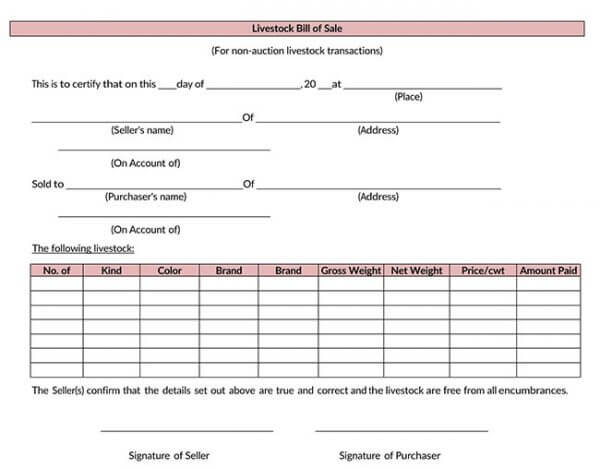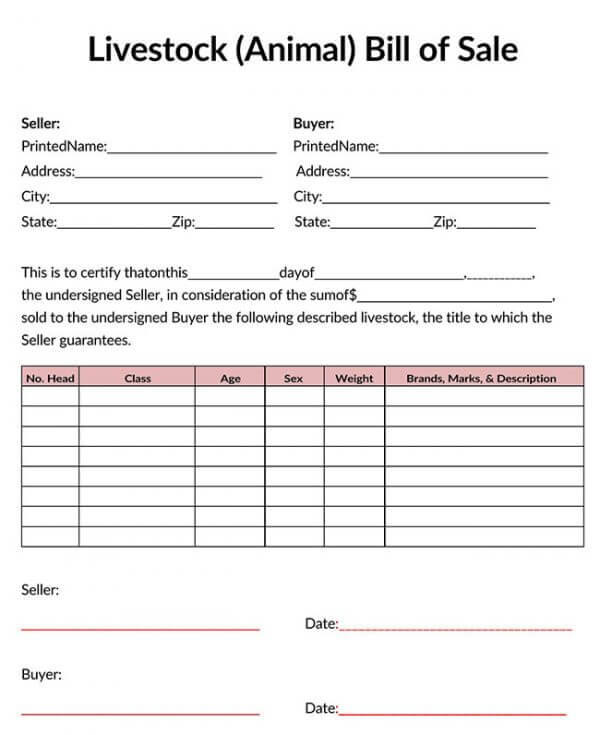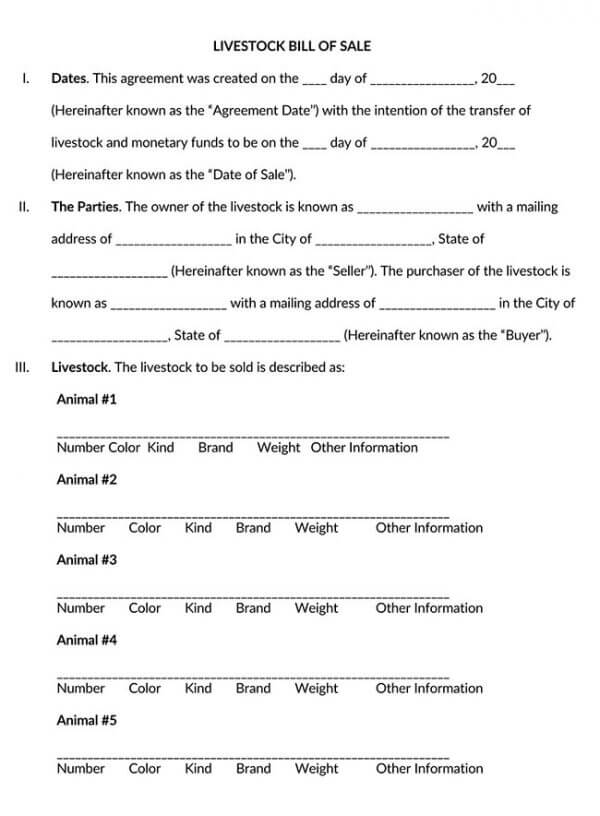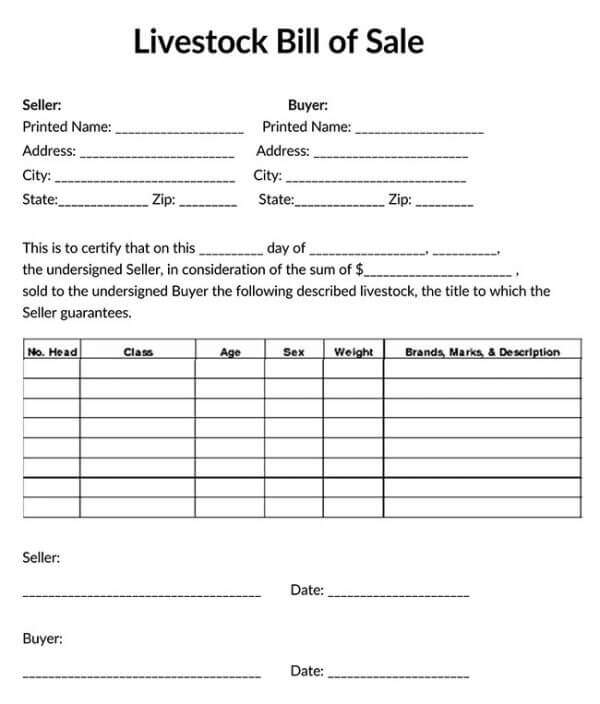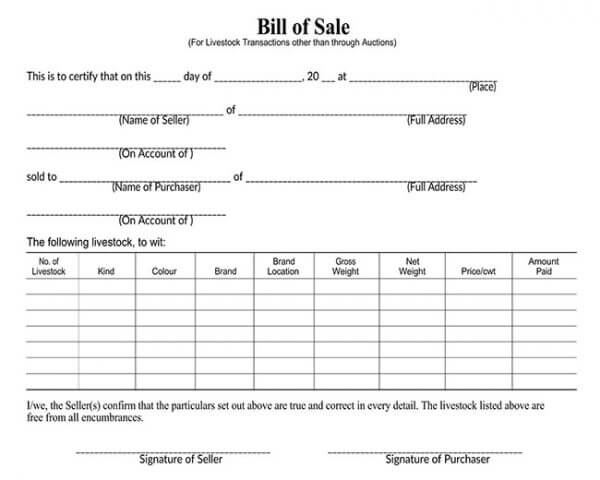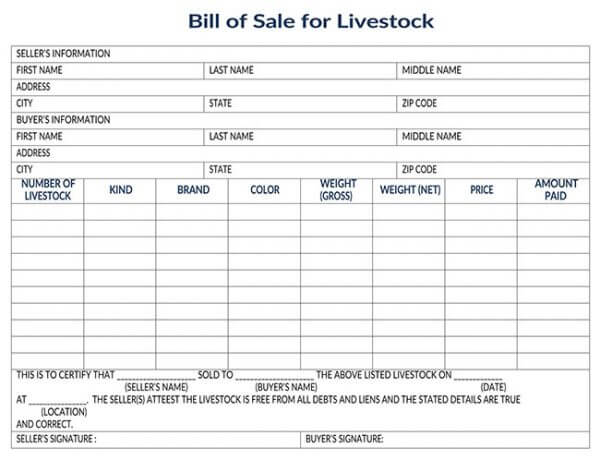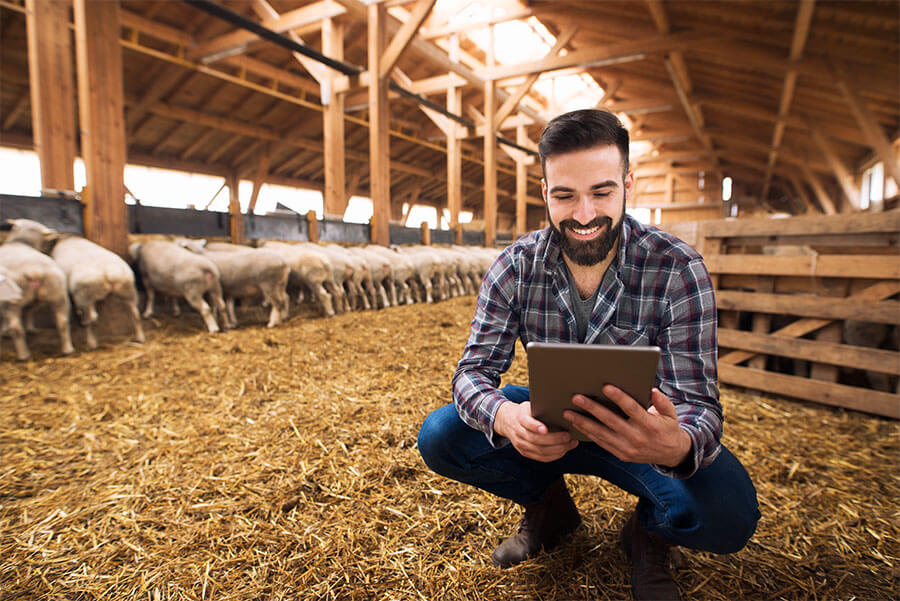The livestock Bill of sale documents details pertaining to the transfer of ownership of the livestock and other important details such as the condition of livestock.
Formally;
A livestock Bill of sale can be defined as a contract made between the sale and purchase of livestock such as cows, pigs, chickens, horses, sheep, etc.
Once both parties agreed on details included in the agreement, a date can then be scheduled when the exchange of livestock and money will be done. A livestock Bill of sale has to be witnessed by at least two witnesses and/or a notary public. The buyer is advised first to inspect or have a third party examine the livestock health between the agreement date and the date of sale/purchase. Once ascertained that there are no health issues with the livestock, the transaction can be finalized.
How to Write a Livestock Bill of Sale
When buying or selling livestock, a livestock bill of sale will always be a requirement regardless of whether the sale is through a private sale or auction.
An up to standard livestock and bill of sale will ordinarily contain the following items.
The buyer & seller’s information
The document (bill of sale) should clearly identify who is the buyer and who is the seller in the transaction at hand.
Both parties should the following details;
- Printed Name- Should be the official names of the buyer/seller.
- Address
- City
- State
- Zip
Sale information
The other item to include is the sale information. The information included in this section should be specific and as agreed on. Examples of such information include;
- Date of Sale/Purchase- Date when ownership and monies are transferred from one party to another.
- Purchase Price- The total amount of money the buyer pays the seller for the acquisition of the animal(s).
Description of livestock
The specifications of the batch of livestock being sold should be evident in the bill of sale.
Information that can be used to describe the livestock includes the following;
- Number- It is the number of animals being sold. This number can be categorized depending on the different types of animals being sold.
- Color-
- Kind/ Class- It can also be interpreted as the breed; different breeds of the same type of animal will collect different prices.
- Age- Age is important as it is known to influence the price of the animal in most cases.
- Sex
- Brand
- Weight
- Health
- Vaccinations- It should be present in the medical records so as to help the buyer with continued livestock management.
- Condition
- Brands, Marks, & Description- Any marks (natural or inflicted) that are used to identify the animal(s) should be declared.
- Any other relevant information
Deposit (if necessary)
Where a deposit is required as a commitment for purchase, it should be stated in the bill of sale. The deposit should be given in figures and a due date.
Inspection period
As in most cases, the buyer will need to examine the livestock before committing to buy; the period within which they are expected to have completed this should be stated. In the format of date, month and year.
Signatures & dates
As with other legally binding and formal documents, signatures must be provided to validate the document. This is realized by having both parties sign the document. The date of signing should also be provided.
How to Sell Livestock
Livestock is taken as any other personal property/asset, and their sale is handled like that of any other asset. The seller looks for potential buyers through advertising the livestock. The seller can opt to sell through an agent or as a private sale where the benefit of the latter is that the seller is not required to pay a percentage of the profits made to the agent/third party.
Below are several factors to take into account when selling livestock.
Factors affecting price
The first step should be to calculate the value of the livestock in question. The last thing one wants is to undervalue the livestock. For the seller, the value of the livestock should be giving a return on investment. Pricing livestock can be done by analyzing the local ads and getting an estimate of the average price of similar livestock. It is advised that as a seller, one should start high if one does not mind retaining ownership of the livestock. This way, if there’s a buyer willing to match that bid, it would be to the seller’s benefit. However, if one is in a rush to sell, starting at the low end would attract more buyers.
The price of livestock will be dependent on the following factors;
- Type of Animal
- Age
- Breed
- Weight
- Class
- Sex
- Health Status
- Overall Purpose
Buyers should also familiarize themselves with the current market prices of livestock before bidding.
Advertising livestock for sale
The next step as a seller is to look for potential buyers by notifying the public of the availability of livestock for sale. There are different ways to market livestock, one being printing flyers and posting them at popular local places such as local cafes, etc.; the other alternative is to advertise them online, which is more suitable as it increases the market reach. This is through the different sites available where livestock sellers post their ads to reach potential buyers.
The way to go about this is by creating a descriptive post stating the listing price, photos of the animal(s), and a description of the breed. As a seller, try and respond to any messages pertaining to the animal(s) received through the website.
Preparing the animal(s) for sale
Once a prospective buyer contacts the seller, the animal(s) should be prepared for sale. How to go about grooming and prepping livestock will depend on the type of animal. Any relevant documentation related to ownership, sale, and domestication of livestock should be gathered, for example, registration papers, medical records, pedigree records, and two copies of the livestock bill of sale. If applicable, gather any equipment necessary for showcasing the livestock.
Executing the transaction
Once requests start coming in, it means buyers are interested, and the livestock price is acceptable. The buyers should be dealt with on a case-to-case basis. Both parties should agree on a designated time and place where the livestock can be paraded- usually at their home farm. The animals up for sale are identified, and any questions from the buyer are answered accordingly for clarity. Remember this is a business transaction like any other, and it should be handled as officially possible. Once the buyer is satisfied with the animals’ condition, they can then agree to the listed price or negotiate for a reduction. The seller has the right to accept or reject the bid.
After both parties agree on the list, they can proceed to discuss the convenient payment options available, which include;
- Cash
- Cheque- Whose issuing can be done at the purchaser’s bank to ensure the transaction is completed smoothly.
- Online Payment Service, for example, Paypal.
After payment has been made or authenticated, each party is given a copy of the Bill of sale, and after that, the seller can transfer their ownership of the livestock to the buyer. As a gesture of courtesy, the buyer can help the buyer prepare the livestock for transport.
Download Free Templates
Here are free customized templates:
The Dos and Don’ts of Selling Livestock
It is the objective of most sellers to maximally benefit from the sale. This can be complicated or easy depending on one’s experience and the skill of marketing and selling. To improve one’s livestock selling abilities, below are some dos and don’ts one can adopt.
Do’s
- Always strive to be honest. Misinformation or misrepresentation can be costly to a seller to the point of litigation.
- Offer competitive prices. As a seller, one should not underprice or overvalue their animals. Try and stay within the current market prices.
- Be specific when giving details about the animal(s). Ambiguity can be a turn-off to potential clients.
- Know your lowest bargain price. This is the least amount one can sell the animal(s) and still make a profit. Below this, the transaction is considered not worthwhile.
- Take good pictures. Pictures used when advertising the animals should be appealing to the eye and convincing to the buyer.
- Re-list sale every now and then if the animals have not been sold yet.
Dont’s
- Avoid exaggerating details when advertising the livestock.
- Avoid selling sick or too old animals.
- Avoid setting the price too low or too high. The set price should be competitive with those of other sellers.
- One should not forget to have the vet inspect the livestock. This avoids selling animals with complications.
- Avoid selling livestock to buyers who do not have the necessary knowledge, equipment, or space to raise the animals.
Frequently Asked Questions (FAQs)
How do I write a bill of sale for livestock?
A livestock bill of sale can be written through the following steps; providing the buyer and seller’s information, dating the bill, providing a description and the price of livestock, and signing at the end to validate the document.
Does a bill of sale for livestock need to be witnessed?
Yes. Two witnesses are recommended or, alternatively, a notary public.
What does a bill of sale for livestock need to include?
Basically, a livestock Bill of sale contains the buyer’s and seller’s names, description of livestock, final purchase price, and signatures.
Is a handwritten bill of sale for livestock legal?
Yes. If the seller’s State of residence does not provide a Bill of sale form, one can hand write it, and it would still be legally binding as long as both parties sign it.
